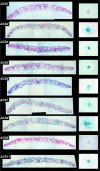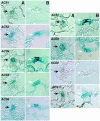Unique and overlapping expression patterns among the Arabidopsis 1-amino-cyclopropane-1-carboxylate synthase gene family members
- PMID: 15466221
- PMCID: PMC523360
- DOI: 10.1104/pp.104.049999
Unique and overlapping expression patterns among the Arabidopsis 1-amino-cyclopropane-1-carboxylate synthase gene family members
Abstract
1-Aminocyclopropane-1-carboxylate synthase (ACS) catalyzes the rate-limiting step in the ethylene biosynthetic pathway in plants. The Arabidopsis genome encodes nine ACS polypeptides that form eight functional (ACS2, ACS4-9, and ACS11) homodimers and one nonfunctional (ACS1) homodimer. Transgenic Arabidopsis lines were constructed expressing the beta-glucuronidase (GUS) and green fluorescence protein (GFP) reporter genes from the promoter of each of the gene family members to determine their patterns of expression during plant development. All genes, except ACS9, are expressed in 5-d-old etiolated or light-grown seedlings yielding distinct patterns of GUS staining. ACS9 expression is detected later in development. Unique and overlapping expression patterns were detected for all the family members in various organs of adult plants. ACS11 is uniquely expressed in the trichomes of sepals and ACS1 in the replum. Overlapping expression was observed in hypocotyl, roots, various parts of the flower (sepals, pedicle, style, etc.) and in the stigmatic and abscission zones of the silique. Exogenous indole-3-acetic acid (IAA) enhances the constitutive expression of ACS2, 4, 5, 6, 7, 8, and 11 in the root. Wounding of hypocotyl tissue inhibits the constitutive expression of ACS1 and ACS5 and induces the expression of ACS2, 4, 6, 7, 8, and 11. Inducers of ethylene production such as cold, heat, anaerobiosis, and Li(+) ions enhance or suppress the expression of various members of the gene family in the root of light-grown seedlings. Examination of GUS expression in transverse sections of cotyledons reveals that all ACS genes, except ACS9, are expressed in the epidermis cell layer, guard cells, and vascular tissue. Similar analysis with root tip tissue treated with IAA reveals unique and overlapping expression patterns in the various cell types of the lateral root cap, cell division, and cell expansion zones. IAA inducibility is gene-specific and cell type-dependent across the root tip zone. This limited comparative exploration of ACS gene family expression reveals constitutive spatial and temporal expression patterns of all gene family members throughout the growth period examined. The unique and overlapping gene activity pattern detected reveals a combinatorial code of spatio-temporal coexpression among the various gene family members during plant development. This raises the prospect that functional ACS heterodimers may be formed in planta.
Figures











 denotes −IAA and • denotes +IAA. Arrows (↑) denote enhanced expression in response to auxin. [Table: see text]
denotes −IAA and • denotes +IAA. Arrows (↑) denote enhanced expression in response to auxin. [Table: see text]
References
-
- Abel S, Nguyen MD, Theologis A (1995. a) The PS-IAA4/5-like family of early auxin-inducible mRNAs in Arabidopsis thaliana. J Mol Biol 251: 533–549 - PubMed
-
- Abel S, Nguyen MD, Chow W, Theologis A (1995. b) ACS4, a primary indoleacetic acid-responsive gene encoding 1-aminocyclopropane-1-carboxylate synthase in Arabidopsis thaliana. Structural characterization, expression in Escherichia coli, and expression characteristics in response to auxin. J Biol Chem 270: 19093–19099 - PubMed
-
- Abeles FB, Morgan PW, Saltveit ME Jr (1992) Ethylene in Plant Biology. Academic Press, New York
Publication types
MeSH terms
Substances
Associated data
- Actions
- Actions
- Actions
- Actions
- Actions
- Actions
- Actions
- Actions
- Actions
- Actions
- Actions
- Actions
- Actions
- Actions
- Actions
- Actions
- Actions
- Actions
LinkOut - more resources
Full Text Sources
Other Literature Sources
Molecular Biology Databases
Miscellaneous

